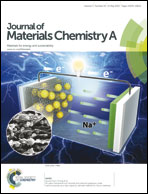Cubic C96: a novel carbon allotrope with a porous nanocube network
Abstract
A novel cubic porous carbon allotrope C96 carbon with intriguing physical properties was predicted. It has 96 atoms in the conventional cell, possessing a Pm![[3 with combining macron]](https://www.rsc.org/images/entities/char_0033_0304.gif) m space group. The basic building block of C96 carbon is a planar six-membered carbon ring. The structural stability, mechanical properties, and dynamical properties of C96 carbon were extensively studied. It is a semiconductor (1.85 eV) with a lower density (2.7 g cm−3) and a larger bulk modulus (279 GPa) and is stable under ambient conditions. The hardness of C96 carbon (25 GPa) is larger than that of T carbon (5.6 GPa). Due to the structural porous feature and lower density, C96 carbon can also be expected to be a good hydrogen storage material.
m space group. The basic building block of C96 carbon is a planar six-membered carbon ring. The structural stability, mechanical properties, and dynamical properties of C96 carbon were extensively studied. It is a semiconductor (1.85 eV) with a lower density (2.7 g cm−3) and a larger bulk modulus (279 GPa) and is stable under ambient conditions. The hardness of C96 carbon (25 GPa) is larger than that of T carbon (5.6 GPa). Due to the structural porous feature and lower density, C96 carbon can also be expected to be a good hydrogen storage material.



 Please wait while we load your content...
Please wait while we load your content...